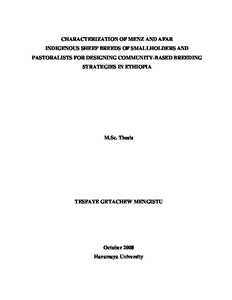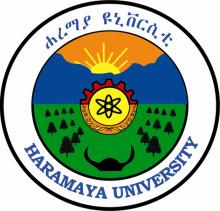Resource information
This study aimed at understanding of existing sheep breeding practices, identifying sheep breeding goals and characterizing the morphological and biometrical characters of Menz and Afar sheep breeds in their habitat as a step towards developing sustainable sheep breeding strategy. The study was conducted by implementing single visit questionnaire, observing and recording of sheep morphological characters, and by recording body weight and body measurements. The survey revealed that the mean sheep flock size per household was 31.6 in Menz and 23.0 in Afar area. Nearly half of the pastoralists in Afar area and one-fifth of smallholder farmers in Menz area do not have breeding ram. The survey revealed the predominance of uncontrolled mating, small flock size and less proportion of breeding male (especially in Afar sheep). Mixing of different sheep flocks within a village was varying by season in both production systems. When flocks are mixed, the inbreeding coefficient could be reduced by 86% in Menz and 78% in Afar sheep flocks. Menz and Afar rams were castrated at the age of 1.7 and 1.5 years, respectively. After castration sheep were kept for longer period of time, 1.9 years (range of 0.25 to 5 years) and 3.1 years (range of 1 to 6 years) for Menz and Afar sheep breeds, respectively. Appearance/conformation was the most important trait in choosing of breeding ram for both Menz and Afar sheep owners. Lambing interval and mothering ability in both crop-livestock and pastoral systems and milk yield in pastoral systems were important traits for the choice of breeding ewes. Sexual maturity age of Menz ram was 10.5 months whereas Afar ram attains sexual maturity at average age of 7.1 months. Age at first lambing, lambing interval, twining rate and lifetime productivity of Menz sheep were 470.1 days, 255.1 days, 1% and 9.3 lambs, respectively. The corresponding values for Afar sheep were 405.6 days, 270.5 days, 5%, 12.1 lambs, respectively. The average market age of male and female Menz sheep were 11.3 and 11.9 months, respectively. Afar sheep were marketed at average age of 6.7 and 8.4 months for male and females, respectively. Afar ewes had mean (standard deviation) milk yield of 224 (54) ml per day with lactation length ranging from 1.5 to 6.0 months. The purpose of keeping sheep in Menz area was to generate income followed by meat, manure, coarse wool and as means of saving, in that order. For Afar pastoralists milk production, meat consumption and income generation are the purposes for keeping sheep. In both production systems, feed shortage, frequent drought and disease were the most important sheep production constraints. Menz sheep are fat tailed (100%) and the tail was curved upward at the tip (99.5). Plain red, white and black coat colours were the dominant colours observed in Menz sheep with proportion of 29.3%, 21.6% and 15.8%, respectively. Almost all (99.1%) of the Menz ewes had no horn whereas most (92.3%) of the rams had horn. About 18.5% of the Menz rams had ruff (long hair around the neck region of the inner part) whereas females had no ruff. Menz rams had no wattle while 6.1% of the ewes had wattle. About 15.4% of the Menz sheep had rudimentary ear, 35.3% had short ear showing a tendency to incline downward and the remaining about half (49.3) of the sheep had larger and dropping/semi-pendulous ears. Afar sheep breed is fat tailed and the tail was curved upward having a wider tail both at the base and at the tip. The major (90%) coat colour of Afar sheep varies from white to light red; white with red patch along the back (41.9%), plain light red (30.9%), plain white (17.2%). Plain dark red accounted for 7% and the remaining few proportions were black, mixture of black and white; and dark grey. Almost all of the Afar sheep (99.2%) had straight head profile. Both sexes of Afar sheep breed are polled. About 2.4% of the female had wattle while all of the males had no wattle. The breed has no ruff, but dewlap is present in both sexes. Majority (78.6%) of the Afar sheep were short eared showing a tendency of inclination downwards and about 19.7% were with rudimentary ear. Long dropping ear found rarely (1.7%). Sex and age of the sheep had a significant (p<0.01) effect on body weight and many of the body measurements. Generally, body weight and measurements were higher for males and also increased as the age increased from the youngest or 0 pairs of permanent incisor (PPI) to the oldest age group (2 and above PPI). Body weight of mature (having 2 and above PPI) Menz ram and ewes were 24.9 ± 0.67 kg and 22.3 ± 0.13 kg, respectively. The corresponding values for Afar rams and ewes were 29.0 ± 0.84 and 24.5 ± 0.14 kg, respectively. Positive and highly significant (P<0.01) correlations were observed between body weight and most of the body measurements. Chest girth had consistently the highest correlation coefficient (0.81 to 0.97%) with body weight in all age groups of both sexes of Menz and Afar sheep. Chest girth also the first variable to enter in to the model of stepwise regression analysis in both males and females of Menz and Afar sheep breeds by explaining the highest variation than other measurement. Thus chest girth could be used for the prediction of body weight, could serve as indirect selection criteria for body weight or it could help to measure progress of selection. The prediction of body weight could be based on regression equation y = -23.42 + 0.67x for Menz rams, y = -23.29 + 0.67x for Menz ewes, y = -30.77 + 0.82x for Afar rams and y = -31.0 + 0.80x for Afar ewes, Where y and x are body weigh and chest girth, respectively. It was concluded that genetic improvement programs targeting smallholder farmers in mixed crop-livestock and in the pastoral production system need to incorporate trait preference of farmers/pastoralist, multipurpose role of sheep and the existing traditional herding and breeding practices.



